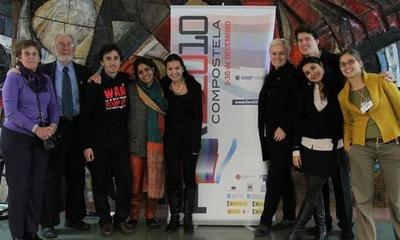|
|
World Report on the Culture of Peace
an article by Marcos Estrada de Oliveira
The World Culture of Peace Report from the Civil Society was
submitted to the United Nations to mark the end of the UN Decade for a
Culture of Peace and Non-Violence for the Children of the World
(2001-2010). It concludes that despite the ending of the Decade, the
global movement for a culture of peace is just beginning.

Youth team with advisors
(left to right) Alicia Cabezudo and David Adams (advisors)
Marcos Estrada, Shreya Jani, Meg Villanueva,
Lillian Solheim, Oliver Rizzi-Carlson, Johanna Ospina, Cecile Barbeito
click on photo to enlarge
The
report was gathered and written by an international youth team (see
photo) who worked intensively over a period of six months. It is
available on the Internet at the Decade Report Website, along with detailed data from all of the 1000 organizations that contributed to the report.
The report was submitted by the Bangladesh ambassador to the
United Nations Secretary General with a request that he transmit it to
the UN General Assembly (GA) as had been requested previously by GA
resolution A/63/80. Although the Secretary General has not responded,
copies of the report were distributed by hand to the GA Member State
representatives during their debate on the Decade at the United Nations.
The report was acknowledged in the final resolution for the
Decade, which "commends civil society, non-governmental organizations
and young people for their activities in further promoting a culture of
peace and non-violence, including through their campaign to raise
awareness on a culture of peace, and takes note that one thousand and
fifty-four organizations from the civil societies of more than one
hundred countries have observed the International Decade, as called for
in paragraph 13 of resolution 64/80."
The youth team continues to present the findings of the report
at meetings and conferences around the world, and is considering how to
continue the exchange of information about culture of peace initiatives,
including the further development of the Culture of Peace News Network
(Click here for a Portuguese version of this article)
|








|
DISCUSSION
Question(s) related to this article:
How can we know if the culture of peace is advancing?
Thematic forum(s) in which this article is being discussed:
GLOBAL MOVEMENT - MOUVEMENT MONDIAL
LATEST READER COMMENT:
The
advancement of culture of peace in any environment cannot easily be
known. Some of the signs of this advancement could be seen and others
can be felt and heard. First and foremost, advancement of this culture
can mainly be clearly noticed in a country where peace was elusive. If
it is an ethnic division that caused conflict and made peace disappear,
the sure sign will be the two factions dialoguing and working together
in improving their relationship. The boundaries created by the conflict
fizzle out and there comes free movement and expressions. People start
talking about peace openly and various avenues are created to educate
the masses about the importance of peace.. . ...more.

|
|
|
This report was posted on April 12, 2011.
If you wish to start a new discussion topic on this article, please copy the title of this article which is World Report on the Culture of Peace and its number which is 456 and enter this information along with your discussion question and an introductory response to the question here.

A few stories are retained on the main listings if they are considered
by readers to be a priority. If you have not already done so, please
take the time to check a box below: should this article be considered as
a priority?

|







